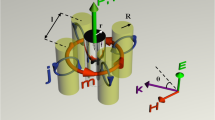Abstract
The aim of this paper is to provide an original method of constructing very effective near-cloaking structures for the conductivity problem. These new structures are such that their first Generalized Polarization Tensors (GPT) vanish. We show that this in particular significantly enhances the cloaking effect. We then present some numerical examples of Generalized Polarization Tensors vanishing structures.
Article PDF
Similar content being viewed by others
References
Alú A., Engheta N.: Achieving transparency with plasmonic and metamaterial coatings. Phys. Rev. E 72, 016623 (2005)
Alú A., Engheta N.: Cloaking and transparency for collections of particles with metamaterial and plasmonic covers. Optics Express 15, 7578–7590 (2007)
Ammari, H., Boulier, T., Garnier, J., Jing, W., Kang, H., Wang, H.: Target identification using dictionary matching of generalized polarization tensors. Submitted to Found. Comp. Math. available at http://arxiv.org/abs/1204.3035 [math.oc], 2012
Ammari, H., Ciraolo, G., Kang, H., Lee, H., Milton, G.: Spectral theory of a Neumann-Poincaré-type operator and analysis of cloaking due to anomalous localized resonance. Submitted, available at http://arxiv.org/abs/1109.0979v2 [math.AP], 2012
Ammari, H., Deng, Y., Kang, H., Lee, H.: Reconstruction of inhomogeneous conductivities via generalized polarization tensors. Submitted
Ammari H., Garnier J., Jugnon V., Kang H., Lee H., Lim M.: Enhancement of near-cloaking. Part III: Numerical simulations, statistical stability, and related questions. Contemp. Math. 577, 1–24 (2012)
Ammari, H., Kang, H.: Polarization and Moment Tensors with Applications to Inverse Problems and Effective Medium Theory, Applied Mathematical Sciences, Vol. 162, New York: Springer-Verlag, 2007
Ammari, H., Kang, H., Lee, H., Lim, M.: Enhancement of near-cloaking. Part II: The Helmholtz equation. Commun. Math. Phys., 2012. doi:10.1007/s00220-012-1620-y
Astala K., Lassas M., Päivärinta L.: Calderon’s inverse problem for anisotropic conductivity in the plane. Comm. Part. Diff. Equat. 30, 207–224 (2005)
Astala K., Päivärinta L.: Calderon’s inverse conductivity problem in the plane. Ann. Math. 163, 265–299 (2006)
Bryan K., Leise T.: Impedance Imaging, inverse problems, and Harry Potter’s Cloak. SIAM Rev. 52, 359–377 (2010)
Greenleaf A., Kurylev Y., Lassas M., Uhlmann G.: Cloaking devices, electromagnetic wormholes, and transformation optics. SIAM Rev. 51, 3–33 (2009)
Greenleaf A., Lassas M., Uhlmann G.: On nonuniqueness for Calderon’s inverse problem. Math. Res. Lett. 10, 685–693 (2003)
Nguyen H.M.: Cloaking via change of variables for the Helmholtz equation in the whole space. Comm. Pure Appl. Math. 63, 1505–1524 (2010)
Kohn R.V., Onofrei D., Vogelius M.S., Weinstein M.I.: Cloaking via change of variables for the Helmholtz equation. Comm. Pure Appl. Math. 63, 973–1016 (2010)
Kohn R.V., Shen H., Vogelius M.S., Weinstein M.I.: Cloaking via change of variables in electric impedance tomography. Inverse Problems 24, 015016 (2008)
Kohn R., Vogelius M.: Determining conductivity by boundary measurements. Comm. Pure and Appl. Math. 37, 289–298 (1984)
Leonhardt U.: Optical conforming mapping. Science 312(5781), 1777–1780 (2006)
Leonhardt U., Tyc T.: Broadband invisibility by non-euclidean cloaking. Science 323, 110–111 (2009)
Liu H.: Virtual reshaping and invisibility in obstacle scattering. Inverse Problems 25, 044006 (2009)
Milton, G.W.: The Theory of Composites. Cambridge Monographs on Applied and Computational Mathematics, Cambridge: Cambridge University Press, 2001
Milton G.W., Nicorovici N.A.: On the cloaking effects associated with anomalous localized resonance. Proc. R. Soc. A 462, 3027–3059 (2006)
Milton G.W., Nicorovici N.A., McPhedran R.C., Podolskiy V.A.: A proof of superlensing in the quasistatic regime, and limitations of superlenses in this regime due to anomalous localized resonance. Proc. R. Soc. A 461, 3999–4034 (2005)
Nachman A.: Global uniqueness for a two-dimensional inverse boundary value problem. Ann. Math. 142, 71–96 (1996)
Pendry J.B., Schurig D., Smith D.R.: Controlling electromagnetic fields. Science 312, 1780–1782 (2006)
Sylvester J., Uhlmann G.: A global uniqueness theorem for an inverse boundary value problem. Ann. Math. 125, 153–169 (1987)
Author information
Authors and Affiliations
Corresponding author
Additional information
Communicated by S. Zelditch
This work was supported by National Institute for Mathematical Sciences (2010 Thematic Program, TP1003), ERC Advanced Grant Project MULTIMOD–267184, Korea Research Foundation through grant KRF-2008-220-C00002, and NRF grants No. 2009-0085987, 2010-0017532, and 2010-0004091, and grants from Inha University.
Rights and permissions
About this article
Cite this article
Ammari, H., Kang, H., Lee, H. et al. Enhancement of Near Cloaking Using Generalized Polarization Tensors Vanishing Structures. Part I: The Conductivity Problem. Commun. Math. Phys. 317, 253–266 (2013). https://doi.org/10.1007/s00220-012-1615-8
Received:
Accepted:
Published:
Issue Date:
DOI: https://doi.org/10.1007/s00220-012-1615-8




